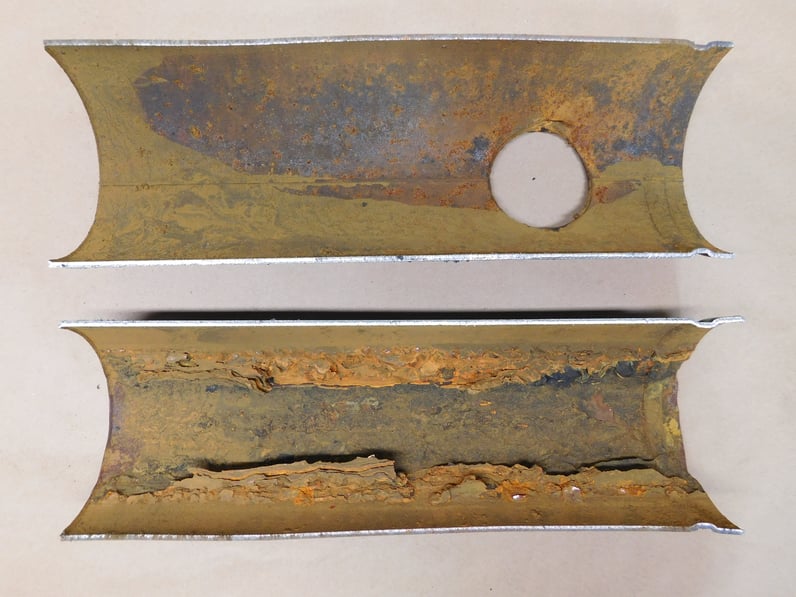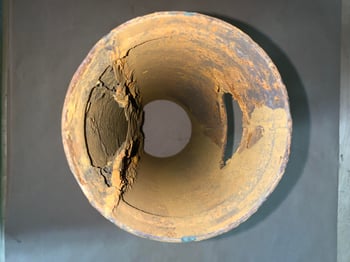The 2017 edition of NFPA 25: Standard for Inspection, Testing, and Maintenance of Water-Based Fire Protection Systems includes sixteen (16) chapters that describe the mandatory minimum requirements for Inspection, Testing, and Maintenance (ITM) of water-based fire sprinkler systems. In addition to the mandatory requirements, the standard also includes eight (8) non-mandatory annexes providing additional information and suggestions on best practices when applying the standard.
The intent of NFPA 25 is to help property owners ensure the operational integrity of their sprinkler system in the event of a fire. However, by attempting to minimize the burden of intrusive testing, the code requirements do not adequately identify the risks of corrosion and obstructions in a fire sprinkler system.
The 2017 Edition of NFPA 25 Chapter 14 and its associated annexes have three main weak points, summarized below:
- Failure to identify testing locations that would be representative of the overall system condition.
- Suggesting water testing as an alternative to an internal inspection or assessment.
- Suggesting use of ultrasonic testing as an alternative to an internal inspection or assessment.
Let's take a closer look at each weakness.
1. Identification of Testing Locations
In our opinion, the largest shortcoming is the code’s failure to provide a list of required inspection locations as part of the five-year internal investigation. Previous editions of NFPA 25 included required inspection locations of a main flushing connection and removal of a sprinkler from a remote branch line. These recommended locations have since been moved to the annex, leaving the method of the inspection up to the contractor or the local AHJ.
It is now known that corrosion in water based fire sprinkler systems, and the resultant deposits formed in the piping network, is typically very localized. Random selection of minimal inspection points is highly likely to miss those locations where corrosion is occurring and fail to identify future leak and obstruction risks. Rather, investigation should focus on those areas where the most severe corrosion occurs.

In wet pipe systems this is the high point(s) of the system, typically the branch lines, where trapped air accumulates. In dry, preaction, and deluge systems, the most severe corrosion occurs in the low points, typically the mains, where trapped water collects. Review of the system as-builts and a site walkthrough can quickly identify potential locations for investigation that provide a much more representative picture of the system condition than visually inspecting one (1) main end cap and one (1) branch line or sprinkler.
2. Water Sample Testing as an Alternative to Internal Inspection
The annex provides several alternative testing methods that can be used instead of an internal inspection of the piping. One of those methods is laboratory analysis of water and solid materials collected from the system for the presence of bacteria that can influence corrosion. While Microbiologically Influenced Corrosion (MIC) is heavily referenced in this section of NFPA 25, as well as many trade publications in the past, the corrosion directly attributable to MIC makes up a very small portion of the corrosion failures that occur in fire sprinkler systems. In the FM Global Data Sheet 2-1 Corrosion in Automatic Sprinkler Systems (October 2016), FM Global makes takes a firm stance regarding MIC"
“Microorganisms are ubiquitous, but detecting MIC-related bacteria in sprinkler water and/or corrosion product samples does not necessarily confirm that MIC has occurred in a fire protection system… In many cases, the presence of MIC-related bacteria may exert some influence on corrosion in fire protection systems, but not as a major contributor.”
The data that ECS has gathered from analyzing thousands of water and pipe samples from fire sprinkler systems correlates strongly with FM Global’s viewpoint. While nearly every water sample analyzed will contain some MIC-related bacteria, there is no correlation between the presence of these bacteria and the severity of the corrosion that has occurred. Simply put, performing water testing to look for bacteria is a waste of time and money and provides little to no usable data to quantify the current condition of a fire sprinkler system.
3. Ultrasonic Testing as an Alternative to Internal Inspection
Another alternative testing method that is mentioned in the annexes is the use of ultrasonic inspection, both for the five-year internal investigation and the obstruction investigation. While the idea of a non-destructive testing method that allows the system to remain in service during the investigation is very attractive to building owners, there are several weaknesses to this approach that must also be considered.
The effectiveness of using ultrasonic testing methods to accurately identify the highly localized corrosion typically found in sprinkler systems, and its ability to reliably quantify the severity of the metal loss, is questionable.
There are several key reasons why the use of ultrasonic testing alone will not provide sufficient data to accurately define the risk posed by corrosion in the fire sprinkler industry:
- Using a finite number of ultrasonic test locations, it is highly likely that localized pitting and weld seam corrosion will be missed.
- To accurately gauge the damage to the system, every location on the system must be tested, which becomes prohibitively time-consuming and costly.
- Ultrasonic testing does not provide any concrete information regarding the location and amount of solid deposits present in the piping. While it is claimed that the presence of corrosion deposits can be identified, the system would still need to be opened to quantify the amount of deposits and whether they pose an obstruction risk, defeating the point of using non-destructive testing methods.
For these reasons, ECS believes that ultrasonic testing is more likely to provide a false sense of security to the building owner by failing to accurately identify the level of risk posed by the internal corrosion of a fire sprinkler system.
ECS Recommendations for Internal Inspections of Fire Sprinkler Systems
One of ECS’s service offerings is the Corrosion Assessment of fire sprinkler systems. While these assessments are often performed on sprinkler systems after they start developing leaks to determine the location and severity of corrosion in the fire sprinkler piping, the inspection methodology can easily be applied to the internal investigations described in Chapter 14 of NFPA 25.

There are three (3) primary investigative tools that are used during these inspections:
- Review of system as-built drawings and leak history to determine most likely locations for corrosion to occur in a given water based fire sprinkler system.
- Video scoping of the system piping to determine the locations within a system where corrosion is taking place and where deposits are accumulating.
- Pipe sample analysis of sections of pipe removed from those locations exhibiting the most severe corrosion to identify corrosion mechanisms at work and severity of the metal loss.
A full Corrosion Assessment can be a time consuming and expensive exercise and may not be the most cost effective approach to meeting the requirement of NFPA 25. However, aspects of the assessment process can be applied to a typical NFPA 25 five-year investigation to provide profoundly more beneficial information while still minimizing the burden placed on the building owner.
If you're interested in learning more about our Corrosion Assessment, download the brochure below or get in touch with us directly.


